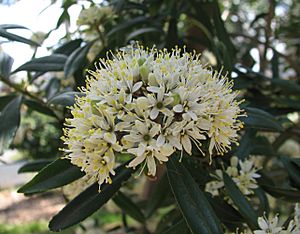Leionema coxii facts for kids
Quick facts for kids Leionema coxii |
|
|---|---|
 |
|
| Scientific classification | |
| Genus: |
Leionema
|
| Species: |
coxii
|
Leionema coxii is a special kind of shrub that only grows in southern New South Wales, Australia. It stands tall and has dark green, narrow leaves. In spring, it bursts with clusters of pretty white flowers.
What it Looks Like
Leionema coxii is usually a pyramid-shaped shrub. It can grow from 1 to 3 meters (about 3 to 10 feet) tall and 1 meter (about 3 feet) wide. Sometimes, it can even become a small tree, reaching 7 to 8 meters (about 23 to 26 feet) high! Its stems grow at an angle and are smooth.
The leaves are long and narrow, shaped like a spear. They are usually 3 to 7 centimeters (about 1 to 3 inches) long and 10 to 15 millimeters (about 0.4 to 0.6 inches) wide. The top side of the leaf is shiny and smooth. The bottom side has a clear line down the middle, and the edges are slightly toothed. Each leaf ends in a sharp point.
This plant produces clusters of 10 to 30 flowers. These flowers grow at the ends of its branches. The flower parts called sepals are yellowish-creamy and shaped like wide triangles. The petals are about 5 millimeters (0.2 inches) long and have tiny dots on them. After the flowers, the plant grows upright fruits that are about 5 millimeters long and have a pointed tip.
How it Got its Name
This plant was first officially described in 1884 by a scientist named Ferdinand von Mueller. He gave it the name Eriostemon coxii. Later, in 1998, another scientist named Paul G. Wilson changed its name to Leionema coxii.
The second part of its name, coxii, honors James Charles Cox. He was a doctor from Sydney who helped promote science in the area.
Where it Lives
You can find Leionema coxii growing in forests and bushy areas. It often lives near rivers and on ridges. Most of these plants are found in the Budawang Range in southern New South Wales. They grow from Morton National Park all the way to the Tuross River area.
See also
In Spanish: Leionema coxii para niños

